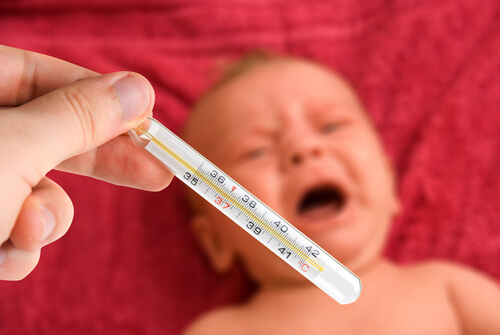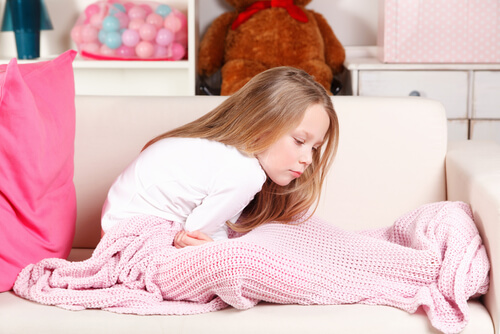How To Treat Hiccups, Fever and Vomiting

Hiccups, fever and vomiting are among the most common scares that parents usually deal with in the first few months of their child’s life. These conditions may show up sporadically for several years and are quite normal, as they are the body’s reaction to something foreign.
Although not related, we want to talk about these conditions together because they are the main cause of alarm in healthy children. Although hiccups cannot be compared to fevers, because one is more serious than the other, both must be adequately controlled so that they do not harm the child later on.
One of the common aspects of these conditions is that they cannot be prevented.
A child gets a fever after being affected by a virus or bacteria whose source is usually unknown. Vomiting is also a response to an agent that is already present in the body. And hiccups are involuntary movements that exert pressure on the diaphragm and begin for no apparent reason.
Below, we will learn how to act in cases of hiccups, fever or vomiting.
A dangerous enemy: children’s fever
Although it is not a disease in itself, fever is a dangerous sign that something more serious is happening in the body. It usually occurs in young children when a pathogen enters the body.

A fever is always worthy of concern. Only when it is persistent and when the child’s temperature rises above 37 degrees Celsius are we talking about something more serious.
Generally, fevers are caused by very common viral infections. These are no cause for alarm and usually, do not require treatment.
What should be done in case of a fever?
Depending on the type of fever, the child may be more or less unwell. To determine the degree of severity, we must observe what other signs of discomfort the child shows.
It is normal for a fever that exceeds 38ºC to disappear within a period no longer than 32 hours. If it persists for more than two days, a specialist should be consulted.
While the child has a fever, follow these recommendations:
- Decrease body temperature with home remedies such as fanning, undressing and humidifying.
- Monitor their temperature constantly.
- Administer the minimum dose of acetaminophen according to medical directions.
- Some mothers bathe their children to lower their temperature. This action is recommended only if you use warm or room temperature water, but never freezing.
- Give them lots of fluids to drink.
Vomiting in children
This is a sign that there is a pathogenic agent in the body. Although it may be related to something that affects the stomach, it is really a sign of a virus, alerting you to the presence of some bacteria or infection in general.
Vomiting in very young children is a concern for parents because as we know, it is a symptom of something bigger and they can not express how they feel. In addition, vomiting can cause the child to suffocate.
Although not all causes of vomiting are serious, it is important to distinguish when the intervention of an adult or a specialist is needed immediately, or if the child must be assisted while vomiting.
Children usually feel considerably better after vomiting. The problem is only when it goes on for a long period of time. For example, if the child has vomited for more than two days, the intervention of a specialist is necessary.

How to handle vomiting?
- Regulate feeding schedules
- Ensure that the child does not eat more than they should for their size
- Ensure hand hygiene
- Be strict with the sterilization of objects that come in contact with the baby
- Maintain good hygiene around foods
- Keep the child hydrated
- Never leave them alone while vomiting
- Be alert to any other signs of discomfort, fever, loss of appetite, pain or diarrhea.
Why do we worry about hiccups?
Hiccups are usually temporary and are almost never caused by a serious condition, a worrisome health problem or care. However, when they are prolonged it can be a sign of neurological, gastric or metabolic diseases.
Babies hiccup for the same reasons as adults, but parents are more concerned because the contraction of their small bodies does not seem normal and is excessively uncomfortable for them.
What to do in the case of hiccups?
Just as the appearance of hiccups is strange, so is the method to stop it. That is, it is not known exactly which of these options may work best in each case.
To help you resolve this concern with your baby, we recommend that you try the following:
- Prevent the baby from eating or drinking too fast
- Do not put them to bed immediately after eating
- Regularly burp them after eating
- Ensure adequate hydration
Hiccups, fever and vomiting are among the most common scares that parents usually deal with in the first few months of their child’s life. These conditions may show up sporadically for several years and are quite normal, as they are the body’s reaction to something foreign.
Although not related, we want to talk about these conditions together because they are the main cause of alarm in healthy children. Although hiccups cannot be compared to fevers, because one is more serious than the other, both must be adequately controlled so that they do not harm the child later on.
One of the common aspects of these conditions is that they cannot be prevented.
A child gets a fever after being affected by a virus or bacteria whose source is usually unknown. Vomiting is also a response to an agent that is already present in the body. And hiccups are involuntary movements that exert pressure on the diaphragm and begin for no apparent reason.
Below, we will learn how to act in cases of hiccups, fever or vomiting.
A dangerous enemy: children’s fever
Although it is not a disease in itself, fever is a dangerous sign that something more serious is happening in the body. It usually occurs in young children when a pathogen enters the body.

A fever is always worthy of concern. Only when it is persistent and when the child’s temperature rises above 37 degrees Celsius are we talking about something more serious.
Generally, fevers are caused by very common viral infections. These are no cause for alarm and usually, do not require treatment.
What should be done in case of a fever?
Depending on the type of fever, the child may be more or less unwell. To determine the degree of severity, we must observe what other signs of discomfort the child shows.
It is normal for a fever that exceeds 38ºC to disappear within a period no longer than 32 hours. If it persists for more than two days, a specialist should be consulted.
While the child has a fever, follow these recommendations:
- Decrease body temperature with home remedies such as fanning, undressing and humidifying.
- Monitor their temperature constantly.
- Administer the minimum dose of acetaminophen according to medical directions.
- Some mothers bathe their children to lower their temperature. This action is recommended only if you use warm or room temperature water, but never freezing.
- Give them lots of fluids to drink.
Vomiting in children
This is a sign that there is a pathogenic agent in the body. Although it may be related to something that affects the stomach, it is really a sign of a virus, alerting you to the presence of some bacteria or infection in general.
Vomiting in very young children is a concern for parents because as we know, it is a symptom of something bigger and they can not express how they feel. In addition, vomiting can cause the child to suffocate.
Although not all causes of vomiting are serious, it is important to distinguish when the intervention of an adult or a specialist is needed immediately, or if the child must be assisted while vomiting.
Children usually feel considerably better after vomiting. The problem is only when it goes on for a long period of time. For example, if the child has vomited for more than two days, the intervention of a specialist is necessary.

How to handle vomiting?
- Regulate feeding schedules
- Ensure that the child does not eat more than they should for their size
- Ensure hand hygiene
- Be strict with the sterilization of objects that come in contact with the baby
- Maintain good hygiene around foods
- Keep the child hydrated
- Never leave them alone while vomiting
- Be alert to any other signs of discomfort, fever, loss of appetite, pain or diarrhea.
Why do we worry about hiccups?
Hiccups are usually temporary and are almost never caused by a serious condition, a worrisome health problem or care. However, when they are prolonged it can be a sign of neurological, gastric or metabolic diseases.
Babies hiccup for the same reasons as adults, but parents are more concerned because the contraction of their small bodies does not seem normal and is excessively uncomfortable for them.
What to do in the case of hiccups?
Just as the appearance of hiccups is strange, so is the method to stop it. That is, it is not known exactly which of these options may work best in each case.
To help you resolve this concern with your baby, we recommend that you try the following:
- Prevent the baby from eating or drinking too fast
- Do not put them to bed immediately after eating
- Regularly burp them after eating
- Ensure adequate hydration
All cited sources were thoroughly reviewed by our team to ensure their quality, reliability, currency, and validity. The bibliography of this article was considered reliable and of academic or scientific accuracy.
- Consolini, D. Fiebre en lactantes y niños. Manual MSD (Versión para profesionales). [En línea].
- Consolini, D. Náuseas y vómitos en lactantes y niños. Manual MSD (Versión para profesionales). [En línea].
- Greenberger, N. Hipo. Manual MSD (Versión para profesionales) [En línea].
This text is provided for informational purposes only and does not replace consultation with a professional. If in doubt, consult your specialist.








